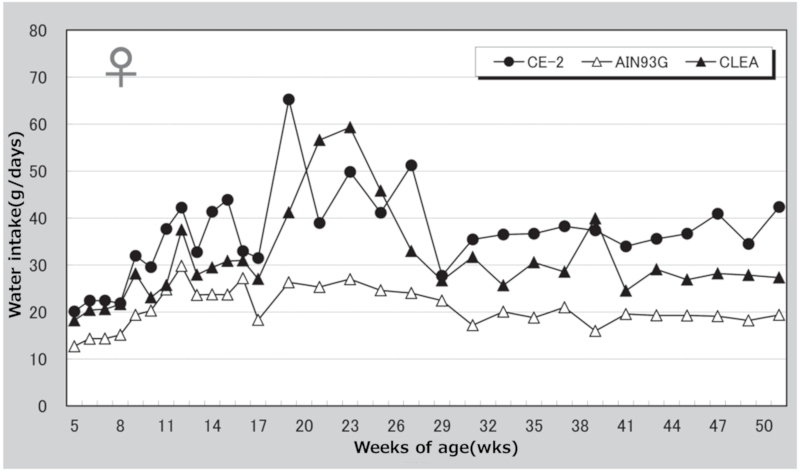
Diet Research Data:Long-term Feeding Study of AIN-93G and CLEA Purified Diets in BrlHan:WIST@Jcl(GALAS) Rats
1.Objectives, Materials and Methods
2.Analytical Results of Experimental Diets
3.Experimental Results
①.Feed Intake
②.Water Intake
③.Body Weight
④.Organ Weight
⑤.Blood Biochemical Parameters
Related CLEA Japan product: CE-2

For the animal, please click here↓![]() : https://www.clea-japan.com/en/products/general_diet/item_d0030
: https://www.clea-japan.com/en/products/general_diet/item_d0030
Related CLEA Japan product: AIN-93G

For the animal, please click here↓![]() : https://www.clea-japan.com/en/products/special_diet/item_d0220
: https://www.clea-japan.com/en/products/special_diet/item_d0220
Inquiry:
If you have any question, please feel free to contact us from here.
1.Objectives
The aim of this study was to collect baseline data on special diets for mice and rats and to gather long-term feeding data for AIN-93G and CLEA purified basal diets.
2.Materials and Methods
(1)Experimental Animals
BrlHan:WIST@Jcl(GALAS) rats (48 males and 48 females) were used in this study.
(2)Diets
The experimental diets consisted of CE-2 (control), AIN-93G, and CLEA purified basal diet (CLEA).
(3)Experimental Design
Rats were introduced at 4 weeks of age and acclimated to the CE-2 diet for one week. Subsequently, they were divided into three groups of 16 males and 16 females each, ensuring similar body weights. From the age of 5 weeks, each group was fed a different diet. The experiment was conducted in the mouse and rat breeding room of Nippon Compound Feed Manufacturing Co., Ltd. Central Research Laboratory (conventional, temperature: 23±2°C, humidity: 40-60%, 12-hour light-dark cycle (light: 9:00-21:00)). Rats were housed in pairs in wire mesh cages (Rat Bracket Cage manufactured by CLEA Japan Inc. ; 260×380×180mm). Both feed and drinking water (tap water) were provided ad libitum.
(4)Measurements
- General condition: Observed daily.
- Feed and water intake: Weekly feed and water intake were measured, and daily averages were calculated. However, measurements were taken every other week from 17 weeks of age.
- Body weight: Measured weekly. However, measurements were taken every other week from 17 weeks of age.
- Organ weight: At 4, 12, 24, and 48 weeks after the start of feeding (9, 17, 29, and 53 weeks of age, respectively), four rats (two cages) from each group were fasted for 24 hours and then sacrificed under sevoflurane (Sevoflurane, Maruishi Pharmaceutical Co., Ltd.) anesthesia. After blood was collected from the posterior vena cava, organs were collected. The organs measured were the heart, liver, kidneys, and spleen.
- Blood biochemical parameters: Blood samples were centrifuged to separate serum and plasma, stored at -80°C, and sent to CLEA Japan Fujinomiya Technical Service Center (FTSC) the following week for analysis.
(Measurement items: ALT, AST, ALP, Glu, T.C, T.P, Ca, CI, BUN, CRE)
3.Statistical Analysis
- Multiple comparison tests using the Tukey-Kramer method were performed, and significant differences between groups at the 5% level are indicated.
Table 1. General Compositional Analysis of Experimental Diets

*For AIN-93G and CLEA diets, crude fiber was calculated based on the formulated value due to the difficulty of analysis using official methods.
①.Feed Intake

Figure 1. Changes in food intake over time in male rats.
Table 2. Changes in food intake over time in each group of male rats.


Figure 2. Changes in food intake over time in female rats.
Table 3. Changes in food intake over time in each group of female rats.

②.Water Intake

Figure 3. Changes in water intake over time in male rats.
Table 4. Changes in water intake over time in each group of male rats.


Figure 4. Changes in water intake over time in female rats.
Table 5. Changes in water intake over time in each group of female rats.

③.Body Weight

Figure 5. Changes in body weight over time in male rats.
Table 6. Changes in body weight over time in each group of male rats.


Figure 6. Changes in body weight over time in female rats.
Table 7. Changes in body weight over time in each group of female rats.

④.Organ Weight
Table 8. Organ weights at necropsy in male rats.

Significant differences are indicated by different signs (P < 0.05).
Table 9. Organ weights at necropsy in female rats.

Significant differences are indicated by different signs (P < 0.05).
⑤.Blood Biochemical Parameters
Table 10. Blood biochemical parameters in male rats at 9 weeks of age.

Significant differences are indicated by different signs (P < 0.05).
※: Measured in heparinized plasma.
Table 11. Blood biochemical parameters in male rats at 17 weeks of age.

Significant differences are indicated by different signs (P < 0.05).
※: Measured in heparinized plasma.
Table 12. Blood biochemical parameters in male rats at 29 weeks of age.

Significant differences are indicated by different signs (P < 0.05).
※: Measured in heparinized plasma.
Table 13. Blood biochemical parameters in male rats at 53 weeks of age.

Significant differences are indicated by different signs (P < 0.05).
※: Measured in heparinized plasma.
Table 14. Blood biochemical parameters in female rats at 9 weeks of age.

Significant differences are indicated by different signs (P < 0.05).
※: Measured in heparinized plasma.
Table 15. Blood biochemical parameters in female rats at 17 weeks of age.

Significant differences are indicated by different signs (P < 0.05).
※: Measured in heparinized plasma.
Table 16. Blood biochemical parameters in female rats at 29 weeks of age.

Significant differences are indicated by different signs (P < 0.05).
※: Measured in heparinized plasma.
Table 17. Blood biochemical parameters in female rats at 53 weeks of age.

Significant differences are indicated by different signs (P < 0.05).
※:Measured in heparinized plasma.


